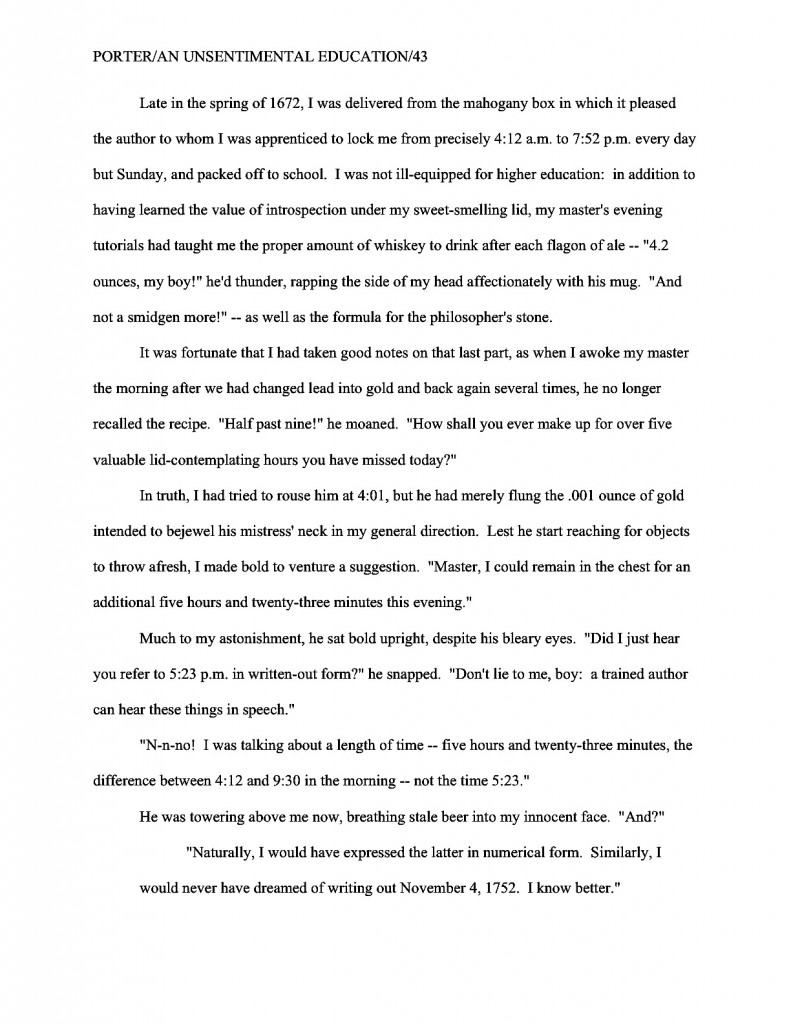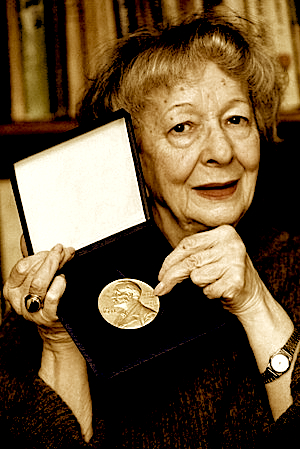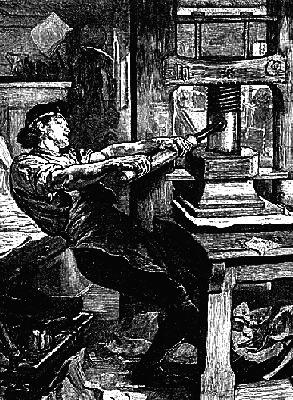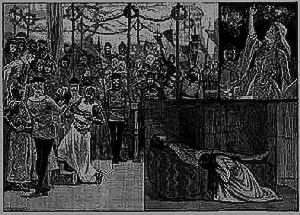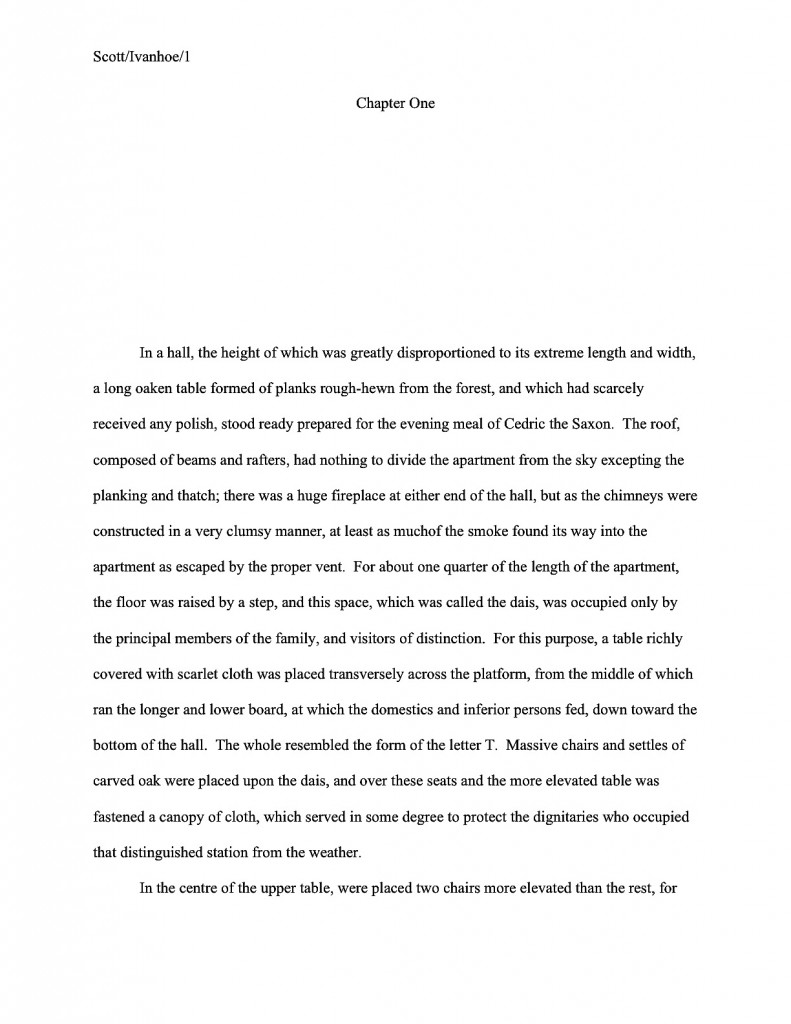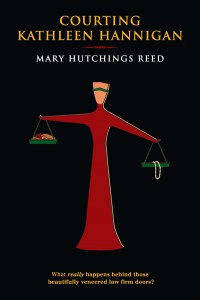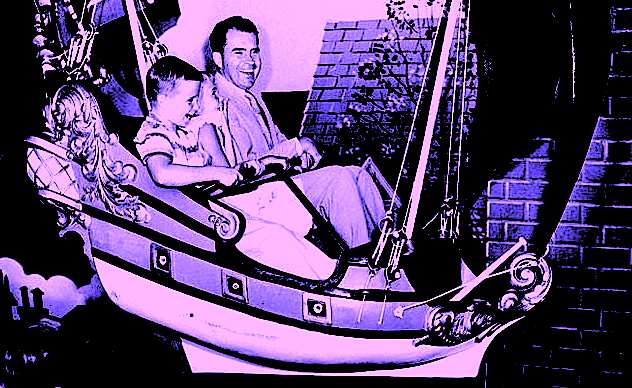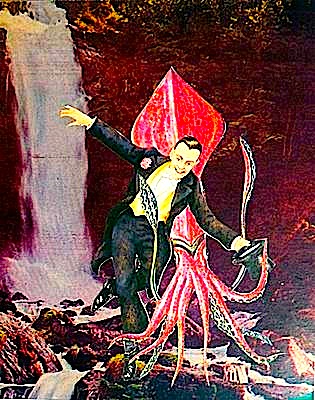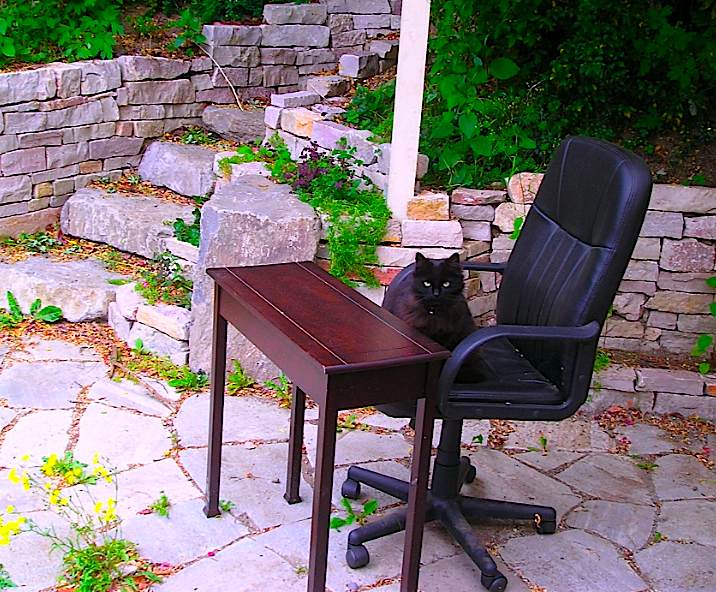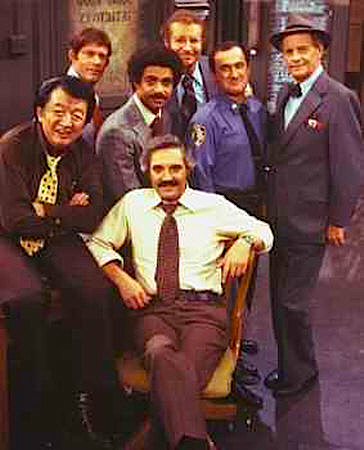
You’re expecting me to open today’s post with a bait-and-switch, are you not? It’s a conditioned response around this time of year — a good 80% of daily and weekly columnists, regardless of their habitual subject matter, may reasonably be expected to open their April 1 posts with an apparently straight-faced telling of an improbable tale, only — surprise! — it turns out not to be true. Har de har har — April fool!
Is anyone over the age of 10 still caught off-guard by this strategy at this point of the calendar? I find it hard to believe, yet much like young men whistling and catcalling after women in the street in order to attract them, I guess we have to assume that it must have worked at least once in human history. Otherwise, it would just be silly to keep doing the same obvious thing over and over again, wouldn’t it?
Why, yes, that does relate to our topic du jour, now that you mention it. How clever of you to notice.
Last time, I began telling you the story of Passive Paul, inert protagonist extraordinaire. Doubtless a charming fellow in real life, Paul is problematic as the center of a book’s interest because his devotion to constant courtesy, never taking even the slightest risk, however trivial, avoiding confrontation of every sort, and extensive internal monologuing render his entrance into virtually any scene of his own book a signal to the reader to start yawning now.
Or, to put it a touch more generously, a reader — particularly a professional one like Millicent the agency screener — might like him to do a bit more and ponder a bit less.
What tends to end up on the page, in short, is a great deal of what we here on the West Coast call processing: lengthy examination of self, loved ones, and/or a situation in order to wring every last drop of psychological import from Paul’s life.
So I repeat my rather disturbing question from last time: why does a character like Paul deserve to have an entire book devoted to him?
This question is infinitely harder to answer in the case of a passive protagonist than an active one. After all, the Pauls of this world almost never cause the central problems of a plot — far from it. He’s usually the guy who tries to get everyone to calm down. Passive Paul has taken to heart Ben Franklin’s much-beloved maxim, “He in quarrels interpose/must often wipe a bloody nose.”
Paul just doesn’t want to get involved, you know?
Oh, he says he does, and certainly thinks he does, often in pages upon pages of unsaid response to what’s going on around him. But deep down, he’s a voyeur — a very specific kind of voyeur who likes to watch the world through a magnifying glass at a safe distance.
Like a bird perched on a tree, peering down at the accident on the street below him, Paul’s basically an observer of the plot, at best. At worst, he’s part of the scenery.
Even when the plot thickens enough to make his life exciting, all he really wants is for the bad things happening to him to be happening to somebody else four feet away. As a result, he watches conflict between other characters without intervening, as if they were on TV. Oh, he may comment vociferously upon what’s going on, especially if he happens to be the narrator, but he seldom takes on the responsibility of making something new happen.
Yes, plenty of people feel that way in real life. We all have our moments of adolescent yearning when we long to have the entire universe rearrange itself around us, in order to get us what we want. But as appealing and universal as that fantasy may be, it is very, very hard to turn into an exciting plot.
But oh, do aspiring writers ever try! Thus the perennial popularity of Ordinary Joes who are unwittingly drawn into Conspiracies Beyond their Ken as protagonists. Yet if Joe simply wanders from scene to scene, observing what’s going on, he runs the risk of becoming set decoration, rather than the primary mover and shaker of the plot.
Do I spot some active hand-waving out there? “But Anne,” creators of sedentary protagonists everywhere exclaim, “surely it’s not an all-or-nothing proposition, either a strong and silent John Wayne type muscling his way from conflict to conflict or a Marcel Proust character lingering in bed for several hundred pages at a time, mentally reviewing his life. If I don’t show my protagonist thinking through his options, I’m afraid he’ll come across as, well, a trifle dim-witted. And my book’s conflicts are too complicated to be resolved without fairly involved thought.”
I’m not sure that there was actually a question in there — passive protagonists are noted for their ability to avoid direct questions, which might be considered confrontational; it’s not called passive-aggressive questioning for nothing — but you’re quite right that protagonists are seldom all active or entirely passive.
What I’m really talking about here is a habitual tendency to slow down a plot and/or minimize conflict by stopping the action cold while the protagonist processes. The danger, from the reader’s perspective, is if he remains still enough for too long at a stretch, the book no longer seems to be about him; it’s about his environment. He might as well be wallpaper on the walls of his life.
Worse than wallpaper, in some cases: while wallpaper is usually pretty innocuous (although admittedly, the 1960s and 70s did produce some aggressively eye-searing patterns), seldom actually interfering with what humans are doing in the room it decorates, Passive Paul does have an effect upon the plot. It’s a negative one: he’s the guy standing in the way of the reader finding out what happens next.
Yes, really. Unlike your average strip of wallpaper, the fact that Passive Paul could make a move to affect the world around him, but apparently chooses not to act to do so, renders him merely obstructive to the reader. However, if he obstructs her view of an interesting plot or characters long enough — or, still more common, if his primary contributions to conflict-ridden scenes are to try to avoid or end the conflict — she may eventually find him downright annoying.
Annoy her enough, and she may find herself pulled entirely out of the story — and once that’s happened, it’s hard for most readers to get back into it. The average Millicent, of course, doesn’t even try: “Next!”
Having trouble picturing how nice, friendly Passive Paul provoked such extreme reactions? Okay, let’s place him in a — sacre bleu! — conflictual situation, to see how he tends to respond to it.
Say, for the sake of argument, that Paul encounters a thorny problem, one that would require him to
(a) make a decision,
(b) take some action that will disrupt the status quo of his life, and frequently
(c) learn an important lesson about himself/love/commitment/life with a capital L in the process.
How does he handle it? Simple: he dons his proverbial thinking cap…
(Insert Musak or other appropriate hold music here. Writers LOVE working through logical possibilities in their heads, so their protagonists seldom lack for mulling material.)
…and two pages later, he’s still running through the possibilities, which are often very interesting.
Interesting enough, in fact, that they would have made perfectly dandy scenes, had the author chosen to present them as live-action scenes that actually occurred within the context of the plot. Instead, they tend to be summarized in a few lines, told, rather than shown, but analyzed to the last drop.
Did that set off warning bells for anyone but me? On about 45 levels, most of which would involve Millicent the agency screener muttering, “Show, don’t tell,” under her breath while perusing a manuscript submission?
“But Anne,” lovers of sedentary protagonists point out, “you’re presenting me with a narrative difficulty. Real-life people are acted upon by forces beyond their control all the time; we don’t need to be in the middle of an economic downturn to notice the difference between being laid off because your company is downsizing and quitting a job the employee never liked very much in the first place. (Possibly because it interfered with his writing time.) Heck, you’re constantly telling us that the best path to writerly happiness is to learn what parts of the querying and submission process are and are not within the writer’s control. So how am I supposed to reflect reality in my writing without depicting my protagonist as caught in the throes of forces beyond her control — or by showing her mulling through what’s going on until she figures out what those forces are?”
Excellent compound question, processing aficionados. Allow me to respond by telling you the story of my all-time least-favorite April fool’s joke, with a passive protagonist in a first-person narrative. Take it away, Paul!
Because the economy wasn’t exactly clamoring for those of us with liberal arts degrees in the mid-1980s — although when has it ever? — half the people with whom I went to college were forced to take up temping after graduation. It was just placeholder employment, we told ourselves, until something better came along. Or until we got admitted to graduate school, whichever came first.
After seven or eight months of only occasional temp assignments and practically no job interviews, I was beginning to doubt that I was employable at all. My girlfriend hadn’t graduated yet, so I was camping out in her dorm room, much to her roommate’s chagrin. So when the lady from Sudden Help called to offer me a one-day job at the aquarium, I snapped it up immediately.
“The regular receptionist refuses to work on April first,” the manager told me, leading me to the telephone bank I was supposed to man until five p.m. “I think you’ll figure out why.”
Scarcely had I seated myself when the phone rang. “New England Aquarium,” I sang out, determined to be chipper at all costs.
“Mr. Fish, please. I’m returning his call.”
I searched through the directory. “I’m sorry, but there’s no Mr. Fish here. Could you tell me which department…”
“Oh, God,” my caller interrupted, beginning to chortle. “Did you say this is the aquarium? I’m going to get Mandy back for this.”
She hung up before I caught onto the joke: Mandy, whoever that was, had left her a message to call not a person, but a fish. And where do you call if you you want to reach a fish? Not bad. I’d have to file that one away for future April Fooling.
I was still giggling when I answered the next call. “New England Aquarium. How may I direct your call?”
“A. Shark, please.”
Oh, dear — was this going to go on all day? It hadn’t occurred to me that it might not be a one-time affair. If I every other call was going to be the same joke, I’d better come up with a way to break it to people gently. “I’m afraid you’ve been the victim of a prank, sir. I’m sure we have sharks, but I can’t connect you to them.”
“Why not? I’ve got a message here to call A. Shark.”
Clearly, the guy wasn’t the brightest bulb in the box. I waited for him to get the joke. “This is the New England Aquarium. Get it?”
“Now, look, Buster…”
“Please lower your voice. I’m just trying to explain…”
“Put my call through, or I’m gonna complain to your manager!”
By the time I had calmed him down, I not only understood how wise the receptionist had been to take the day off annually, but was no longer certain I was coming back after lunch. 725 calls later, I could barely make it to the subway stop at the end of the day.
Okay, how did Paul slow this story down with his passivity? Let me count the ways.
If you said that he spent too many lines explaining what was going on to the reader, give yourself a gold star for the day. First-person narration — and really, tight third-person that lingers to much in the protagonist’s head — is notorious for over-explanation. It tends to slow down the narrative.
Here, it also watered down what could have been quite a funny running bit, had Paul gotten out of its way. The dialogue alone could have made the joke abundantly clear.
Also, Paul was not the character to figure out the joke — the first caller did, right? — that, too, might be construed as being an obstacle to the conflict at hand. Chock up another star if you caught that one. Third, as is so often the case with passive protagonists, his response was redundant, repeating information the reader already knew.
“Yes, yes, we get it,” Millicent mutters. “Fish at an aquarium. Move on with it!”
What’s the problem with conceptual repetition, long-term readers? It’s predictable — as are most passive protagonists, when you come to think about it. (And believe me, Millicent does think about it. All the time.) An unfailingly polite character may be relied upon to be courteous, right? A habitual conflict-avoider will constantly eschew conflict. Someone who never talks back to his boss in pages 1-175 will probably continue to be reticent until the last chapter of the book — and perhaps will keep his trap shut even then.
And so forth. Wouldn’t a more changeable character’s responses surprise readers more?
Award yourself three extra stars if you caught the slightly subtler way that Paul slowed down the narrative here: he’s presented himself as the victim of every external force within this scene. His employment problems are shared by millions, but does he try a different solution than the undifferentiated masses? He even lumps himself in with them, referring to everyone concerned in the first person plural. Outside forces even drove him to say yes to the job in the anecdote — and rather than asking intelligent follow-up questions once he gets there, he plays straight man until the first caller clues him in on what’s happening. And even though he’s not the butt of the joke the second time around, Paul thinks only of how the misunderstanding might affect himself.
That self-centerness isn’t precisely a surprise in a passive protagonist, is it? Characters who feel sorry for themselves are particularly prone to thought-ridden passivity. Life happens to Paul, and he reacts to it.
Does he ever! Oh, how lucidly he resents the forces that act upon him, as he sits around and waits for those forces to strike at him again! How little does the external pressure affect his basic niceness as he mulls over the problems of his life! How redolent of feeling do the juices in which he is stewing become!
This is fine for a scene or two, but remember, professional readers measure their time waiting for conflict in lines of text, not pages. To say that they bore easily is like saying that you might get a touch chilly if you visited the North Pole without a coat: true, yes, but something of an understatement, and one that might get you pretty badly hurt if you relied upon it too literally.
Don’t get me wrong — I’m not saying that Paul could not be written about well, or even that a novel or memoir in which he was the protagonist would necessarily be unmarketable, even in the current super-tight, oh-my-God-when-will-this-recession-end? literary market.
What I am saying is that Paul’s creator would have to work awfully hard to make his story exciting. Just as a reader may guess a passive protagonist’s probable responses half a page away, a pure observer’s storyline tends to be, among other things, predictable.
Yes, yes, there are plenty of good books where the protagonists sit around and think about things for entire chapters at a time. But before you start quoting 19th-century novelists (or memoirists, for that matter) who habitually had their leads agonize for a hundred pages or so before doing anything whatsoever, ask yourself this: how many books of this ilk can you name that were published within the last five years?
Come up with many? Okay, how many of the ones you have in mind were written by first-time novelists or memoirists?
Okay, how about ones not first published in the British Isles or ghostwritten for celebrities?
Think up even one? If you did, could you pass their agents’ names along to the rest of us with all possible speed?
Paul’s creator has a book that might interest ‘em. In the current very tight literary market, there aren’t many North American agents who harbor this preference — and still fewer who act upon it in establishing their client lists.
And no, beautiful writing alone usually isn’t enough to get Millicent to pass a submission featuring a passive protagonist on to her boss. Professional readers see beautiful writing about inert characters more than you might think. Especially if they represent literary fiction or memoir.
Why? Well, unfortunately, there seems to be a sizable and actively writing portion of the aspiring author community that proceeds on the assumption that literary fiction shouldn’t be about anything in particular — except characterization, of course. A plot distracts from the glory of those stellar sentences, I guess. Or if it is about something, it should be about the kinds of moments that work so well in short stories: exquisitely rendered instants fraught with significance.
You know, the type of hyper-examined human interaction that is really, really hard to sustain for longer than 20 pages or so. Partially — and see if this sounds at all familiar — because all of that observation and reaction tends to keep the narrative, if not mostly within the protagonist’s head, then at least within his body, for most of the piece.
Just in case anyone doesn’t already know this, literary fiction refers to the writing style, experimental use of language, and/or the expectation of a college-educated readership, not the plotline. Cormac McCarthy’s hyper-literary recent hit THE ROAD is a reworking of a premise long familiar to any SF/fantasy reader, after all; it’s the writing that makes it literary fiction.
So yes, Virginia, literary fiction can have a plot. It can even move the reader through that plot swiftly.
Memoir submissions often suffer from a similar reluctance to step outside the protagonist’s head into a full and complex world. But while literary fiction submissions tend to hold the magnifying glass up to nature (mostly the nature inside the protagonist’s head, admittedly, but still, nature), memoir manuscripts are frequently collections of loosely-drawn anecdotes.
Why is this problematic, you ask? Well, by definition, most anecdotes are told, rather than shown. Many, many memoir submissions rely so heavily upon the anecdotal style (which seems chattier than a more robust narrative) that they don’t include any fully-realized scenes or fleshed-out characters other than the protagonist.
Which can present a considerable storytelling problem: by definition, anecdotes are one remove away from the reader than a directly-observed scene, right?
Many, if not most, first-time memoirists forget that. In fact, the protagonist’s thoughts tend to be so central to the author’s conception of a memoir that memoirists often act rather puzzled when someone asks them the perfectly reasonable question, “So, what’s your book about?”
“It’s about ME,” they’ll say, astonished that anyone would feel the need to verify anything so obvious. “What else would my memoir be about?”
In a way, they’re right, but in another way, they’re wrong: a good memoir is always about something other than the narrator’s life, at least in part. People don’t grow up in a vacuum, typically, and even anecdotally, most of us will tell the story of our own lives within a context. Which means, in practice, that the memoir can either present the narrator as a mover and shaker within that context, or as a passive (but likeable!) observer of it.
Guess which most memoir submitters pick?
“But wait!” I hear some of you shouting. “Now I’m so paranoid about Passive Paul and his lethargic brethren and sistern that I’m terrified that my book will be rejected every time my protagonist pauses for breath! I’m no longer sure what’s being nice and what’s being passive!”
Never fear, my friends. When you are in doubt about a scene, ask yourself the following series of questions about it, to reveal whether your protagonist is taking an active enough role in, well, his own life. If you can honestly answer yes to all of them, chances are good that you don’t have a passivity problem on your hands. If you find yourself answering no to one or more…well, we’ll talk.
These questions work equally well, incidentally, whether the manuscript in question is a novel or a memoir. (You’re welcome.)
(1) Is it clear why the events being described here are happening to my protagonist, rather than to someone else? (Hint: “Because the book’s about Paul!” is not an insufficient answer, professionally speaking.)
(2) Does the scene reveal significant aspects of my protagonist’s character that have not yet been seen in the book? If it doesn’t, could it? Would having Paul act a little out of character here make the scene more revealing — or more surprising for the reader?
(3) Is there conflict on every page of this scene? If yes, is my protagonist causing some of the conflict? A golden oldie from previous self-editing question lists, admittedly, but always worth asking.
(4) Does the conflict arise organically? In other words, does it seem to be a natural outcropping of a person with my protagonist’s passions, skills, and background walking into this particular situation?
(5) Does this scene change the protagonist’s situation with respect to the plot? Is either the plot or an important interrelationship between the characters somehow different after the scene than before it? If not, is this scene absolutely necessary to keep?
(6) Is my protagonist doing or saying something to try to affect the outcome or change the relationships here? Is the protagonist integrally involved in that change, or merely an observer of it? (Another oldie but goodie.)
(7) If the scene contains dialogue, is my protagonist an active conversational partner? (Hint: if Paul’s linguistic contributions consist of “What?” “What do you mean?” “How is that possible?” and/or “Really?” you should consider tossing out his lines and writing him some new ones.)
(8) If my protagonist is not saying much (or anything), does he honestly care about what’s going on? If he doesn’t feel that the situation warrants intervention yet, are the stakes high enough for the reader to worry about the outcome of this conflict? If not, is this scene necessary to keep?
#8 may seem like a harsh assessment, but make no mistake about it: to the eye of someone who reads hundreds of submissions, a protagonist who observes conflict, rather than getting actively involved in it, seems as though he doesn’t care very much about what’s going on.
Or, to translate this into the language of the industry: if the protagonist isn’t passionate about what’s going on here, why should the reader be?
To be fair, when Millicent asks herself this question, it may not have as much to do with your manuscript as with the last fifty manuscripts the screener read, half of which opened with slice-of-life vignettes that demonstrated conclusively that the protagonist was a really nice person who did everything she could to avoid conflict. After a couple of dozen of these, a rude and pushy Paul can start to seem rather refreshing.
Yes, these are a lot of questions to ask yourself about every questionably-paced scene in the book — but if you don’t plan to implement them right away, there are always those sweltering, sleepless summer nights ahead.
It’s a great alternative to counting sheep, after all, or even birds lingering in the treetops: Passive Paul would never consider using his pondering time to such useful effect. Keep up the good work!

